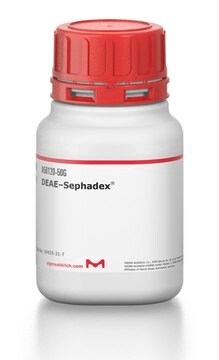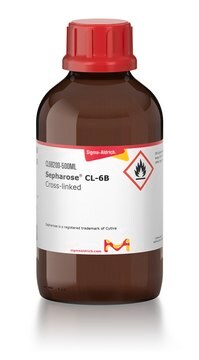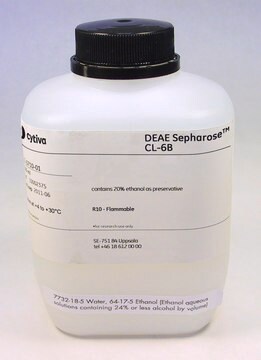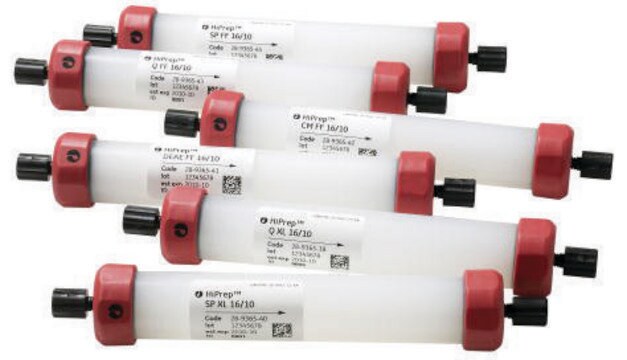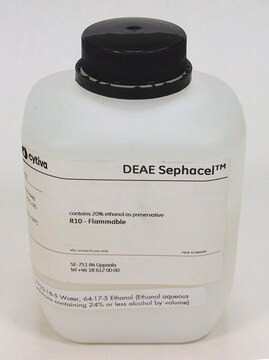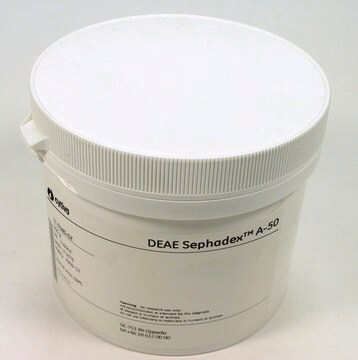DCL6B100
DEAE–Sepharose™
CL-6B
Synonym(s):
Diethylaminoethyl–Sepharose™
Sign Into View Organizational & Contract Pricing
All Photos(1)
About This Item
Recommended Products
Quality Level
form
suspension
technique(s)
affinity chromatography: suitable
matrix
6% cross-linked agarose
bead size
45-165 μm
pore size
~4,000,000 Da exclusion limit
pH
3—12
capacity
130-170 μeq/mL binding capacity (gel volume)(gel volume)
Looking for similar products? Visit Product Comparison Guide
Related Categories
General description
DCL6B100-500ML′s updated product number is GE17-0710-01
Application
DEAE-Sepharose® is used in affinity chromatography, protein chromatography and ion exchange chromatography. DEAE-Sepharose™ has been used to study pathogenesis of human disease and to develop a new assay for detecting the toxins of pathogenic strains of Clostridium difficile.
Legal Information
DEAE-Sepharose is a registered trademark of Cytiva
Sepharose is a trademark of Cytiva
Replaced by
Product No.
Description
Pricing
signalword
Warning
hcodes
Hazard Classifications
Flam. Liq. 3
Storage Class
3 - Flammable liquids
wgk_germany
WGK 1
flash_point_f
100.4 - 109.4 °F
flash_point_c
38 - 43 °C
ppe
Eyeshields, Faceshields, Gloves, type ABEK (EN14387) respirator filter
Choose from one of the most recent versions:
Already Own This Product?
Find documentation for the products that you have recently purchased in the Document Library.
Customers Also Viewed
J J Wheeler et al.
Gene therapy, 6(2), 271-281 (1999-08-06)
A detergent dialysis procedure is described which allows encapsulation of plasmid DNA within a lipid envelope, where the resulting particle is stabilized in aqueous media by the presence of a poly(ethyleneglycol) (PEG) coating. These 'stabilized plasmid-lipid particles' (SPLP) exhibit an
M A Heine et al.
Molecular biology of the cell, 4(11), 1189-1204 (1993-11-01)
Epitope-tagged Xenopus nucleolin was expressed in Escherichia coli cells and in Xenopus oocytes either as a full-length wild-type protein or as a truncation that lacked the distinctive carboxy glycine/arginine-rich (GAR) domain. Both full-length and truncated versions of nucleolin were tagged
R K Sinha et al.
Vaccine, 15(6-7), 689-699 (1997-04-01)
Six different secretory proteins of molecular weights (15, 26, 30, 41, 55 and 70 kDa) were isolated from 8-day-old culture filtrate of Mycobacterium tuberculosis H37Ra using different column chromatography techniques. These proteins were further examined for their ability to induce
I Yu Bakunina et al.
Biochemistry. Biokhimiia, 67(6), 689-695 (2002-07-20)
An alpha-N-acetylgalactosaminidase IV able to remove blood type specificity of human A(II)-erythrocytes and not effecting B(III)-erythrocytes was isolated from the marine bacterium Arenibacter latericius KMM 426T. The alpha-N-acetylgalactosaminidase IV preparation exhibits high activity during inhibition of hemagglutination with blood group
M L Zapp et al.
Proceedings of the National Academy of Sciences of the United States of America, 88(17), 7734-7738 (1991-09-01)
The Rev protein of human immunodeficiency virus type 1 is a sequence-specific RNA binding protein that is essential for viral replication. Here we present evidence that Rev is a stable oligomer both in vitro and in vivo. Analysis of Rev
Global Trade Item Number
| SKU | GTIN |
|---|---|
| DCL6B100-100ML | 4061838214614 |
| DCL6B100-500ML | |
| DCL6B100-50ML | 4061833591406 |
Our team of scientists has experience in all areas of research including Life Science, Material Science, Chemical Synthesis, Chromatography, Analytical and many others.
Contact Technical Service
